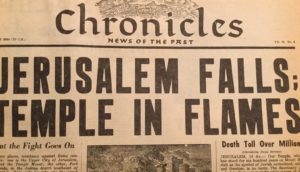
On August 1, 2017, Jews all over the world fasted during the daylight portion because on the Hebrew calendar it was the ninth of Av — the same day both the first and second Jerusalem Temples were destroyed 656 years apart.
Quite a bit has been preserved for us about the players and events leading up to and surrounding the second destruction.
A Bit of Flavian History
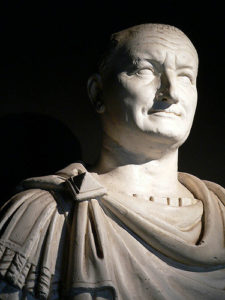
Vespasian
Religious scholars and history buffs learned in 2009 that they had a new reason to visit Italy. The Associated Press reported that a team of Italian and British archaeologists had unearthed the childhood home of Titus Flavius Vespasianus. And the find is said to fit with the description of an ancient historian.
Some may still question whether it’s the actual location, but no one doubts the monumental role Vespasian played nearly 2000 years ago.
He was an important figure in both Italian and British history — having initially highly distinguished himself as a military officer in Rome’s 43 CE invasion of Britain.
Many know him better as Emperor Vespasian, ‘builder’ of Rome’s Coliseum, and father of the Roman military commander credited with the destruction of the second Jerusalem Temple.
The web site of the British School at Rome stated,
“The project is part of a wider series of events programmed for 2009 to mark the bimillenary of the birth of Vespasian.”
The discovery was said to be a large luxurious 2000-year-old country estate located in what could be the center of Falacrine his recorded birthplace. This Falacrine, an ancient town about 80 miles (130 km) northeast of Rome, had also been hidden until few years ago.
Momentous Time
Anna, no less than 84 years old — and the prophetess at the temple when Jesus’s parents brought him there to be consecrated as the law stipulated for firstborn males — had no trouble remembering back to when Judea was autonomous and Rome was still a republic. But, emperors were ruling by the time Jesus from Nazareth, a city in Galilee, was born.
Future Roman emperor, Vespasian, was in his late teens or early 20s, when Jesus was spreading the good news about God’s un-tyrannical government to come. Jesus, before he died, also foretold that the 2nd Temple would be destroyed.
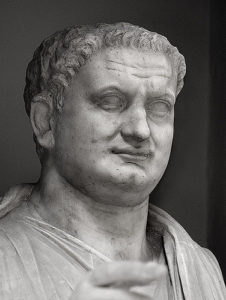
Titus
Like Vespasian, two of the next generation also influenced history significantly. Josephus ben Matthias, son of a Levitical priest, and Vespasian’s eldest son, Titus, were only two years apart. Josephus was born less than a decade after Jesus’s death and Titus a couple of years later. As soldiers, the men would face each other as enemies and yet, ‘truth’ sometimes being stranger than fiction, they would eventually end up like family.
In 43 CE, not much time had passed between the events surrounding Jesus’s death and Vespasian’s march with his Roman soldiers through what are now modern English southwestern counties — including Hampshire, Dorset, Sommerset, Devon, and Cornwall.
What happened roughly two decades later — in a timeframe of less than 5 years — demonstrates how quickly the course of history can change and one’s own life as well.
In 67, Military Commander Vespasian and son Titus start to quell the Judean Revolt started the year before. After the defeat of Jotapata (or Yodfat) in Galilee, Vespasian is informed that Galilee’s resistance leader, Josephus ben Matthias, has been caught.
Josephus’s comment to his captors, in turn, intrigues Vespasian enough that he grants the Judean’s request to speak directly to him.
How Matters Evolved
According to British historian Desmond Stewart and author of the book, “Jerusalem’s Traitor – Josephus, Masada, and the Fall of Judea ”, Vespasian was receptive to what Josephus had to say for several reasons.
The Bible was one of them.
A future Roman Senator and historian, Tacitus, was around 10 years old or so at the time. But as an adult, he wrote about a prophecy circulating for a long time throughout the Eastern provinces of the empire.
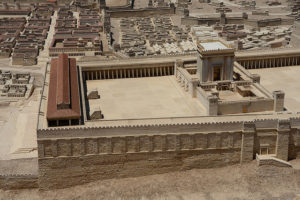
A model of Jerusalem and the 2nd Temple prior to its destruction
These provinces included Judea, of course, and nearby places where other Jews and some descendants from the 10 Northern clans of Israel were still living. People not descended from Jacob, like Tacitus, obviously heard about it too.
A second century Roman historian, Suetonius, referred to the prophecy and agreed that Vespasian had heard of it. The prediction was that a future world ruler would come from Judea.
It plus several other things — including what Josephus was about to tell him — were said to have finally convinced Vespasian and others he knew, that the prophecy could possibly refer to him. After all, he was in Judea at the time.
In 67 CE, Josephus’s audacious statement to Vespasian was,
“that he should be released in a very short time by the same Vespasian, but he [Vespasian] would be emperor first.”
Huge Changes Hit Fast
In 68, the death of Emperor Nero ignited a major power struggle in Rome. That resulted in four Caesars in one year. In 69, Vespasian was declared the next ruler and the direct descendent of Aaron was released.
In 70, the newly proclaimed emperor Vespasian arrived in Italy and immediately set about restoring stability to the capital and peace throughout the vast Roman Empire. In the same year, Vespasian’s brother-in-law suppressed a major revolt in Gaul. Also in 70, his son Titus destroyed the Herodian Temple and essentially concluded the war with Judea.
In less than 4 years Vespasian’s status swiftly changed from a military general focused on ending a revolt in one unruly province to leader of the entire empire.
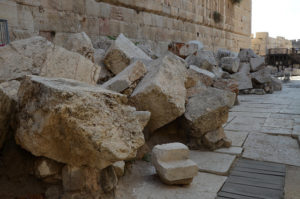
Herodian Temple Complex stones
After the war, life also dramatically altered for all living in Judah. They faced the usual consequences that come with being on the losing side. Plus, the nation had to rapidly adjust to life without a sacrificial system and functioning priesthood since the Temple no longer existed.
More to the Story
Depending on the historical event chosen, it’s said the date for the demise of the republic and birth of the empire can range from around 48 BCE to 27 BCE.
Josephus wrote about the 66-73 CE Jewish revolt. He once was considered a totally unreliable historian because his writings are said to contain exaggerations and discrepancies, as well as silly mistakes that would be caught by a modern proofreader — like saying Mt. Tabor was 20,000 feet (6,096 meters) high instead of 2,000 (575 meters). But after he was closely compared with other ancient writers and other factors considered, attitudes softened significantly.
Much like today in various places, by the 60s Judea had become extremely polarized about issues. The Zealot party became more powerful by playing on people’s differences and concerns. And ultimately, Judeans ended up fighting and killing fellow Judeans even within the Jerusalem Temple complex. Too many failed to realize that the internal divisiveness revealed to the rest of the world their true spiritual state at the time.
Earlier, Vespasian’s men had urged him to go ahead and attack the nation’s capital, Jerusalem. He felt then would be premature. Pages 130-131 of Stewart’s book included Vespasian’s reply.
“If we wait for a bit longer, however, we shall have a lot less of them to fight. … The best thing we can do … is to stay as spectators instead of taking on fanatics who welcome death and are busy murdering each other. … success won with delaying tactics is always infinitely preferable to risking disaster by letting a battle begin too soon.
His assessment proved right.
Josephus’s works and much additional information about him, Titus, and Vespasian are readily available in print and on the Internet.
Photo credits: Vespasian by Mary Harrsch, License: CC BY-NC-SA 2.0; Titus by William Storage, License: CC BY-NC 2.0; Temple model by Maggie & Rick, License: CC BY-NC-ND 2.0; Temple Stones by Carole Raddato, License: CC BY-SA 2.0.